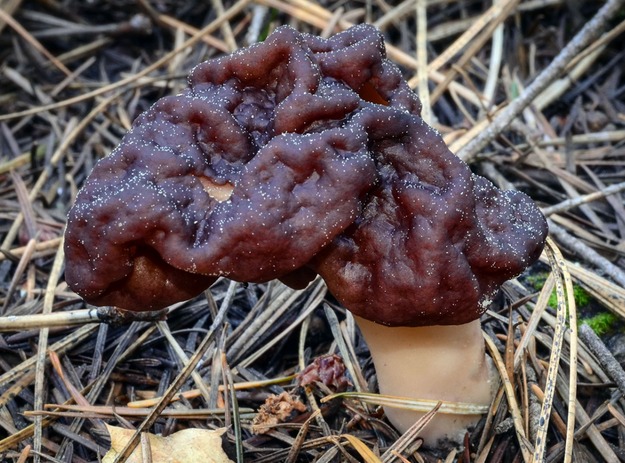Content
The common string is a spring mushroom with a wrinkled brown cap. It belongs to the Discinaceae family. It contains a poison dangerous to human life, which is not completely destroyed after heat treatment and drying.
Description of ordinary line
You can see this mushroom in the forest in spring. Small caps of irregular rounded shape peek out from under the coniferous litter in the pine forest, in places illuminated by the sun.
The wrinkled dark brown caps resemble walnut kernels with their numerous convolutions. The pulp is fragile and light, with a pleasant taste and fruity aroma.
Description of the cap
The common string, shown in the photo, belongs to the marsupial fungi. It has a small wrinkled cap that resembles a walnut kernel or brain in appearance. The diameter of the cap usually does not exceed 14-15 cm, and its height reaches 9-10 cm.
Tiny specimens that have just emerged from the ground have a smooth cap, but over time, deep folds appear on it. The usual color is brown or chocolate brown, but orange or red shades can be found.
Description of the leg
The common stem is small, about 2-3 cm long and 5-6 cm in diameter. Inside it is not filled with pulp, it is hollow, but dense to the touch.
The leg narrows towards the base. It is usually pale gray in color, sometimes with a pinkish or yellowish tint.
Is an ordinary stitch edible or not?
The degree of toxicity of this mushroom greatly depends on the place of growth. The most poisonous representatives of the species were found in Germany. The deadly poison gyromitrin was found in their pulp.
Mushrooms collected in Russia rarely, but still, lead to poisoning. No deaths were observed.
Symptoms of poisoning, first aid
The toxin gyromitrin affects the functioning of the autonomic nervous system and liver. Symptoms of intoxication are dizziness, pain in the stomach, vomiting and nausea. With severe damage to the body, coma occurs.
First aid for poisoning with common stitches is to rinse the gastrointestinal tract and take large doses of sorbent.It is necessary to immediately call an ambulance to avoid complications and death.
How to cook ordinary stitch mushrooms
Mycologists have not come to a consensus on the edibility of the common string. This mushroom is prohibited for sale in many European countries where it grows. The reasons influencing the degree of its toxicity are not yet fully understood. But many mushroom pickers call its collection and preparation “Russian roulette,” a dangerous game that can lead to death at any moment. If the mushrooms contain a high dose of gyromitrin, a 200 gram portion is enough to cause death.
In Russia, ordinary stitches are less toxic than in Western Europe. Knowing the potential danger, mushroom pickers boil them several times, pouring the broth down the drain. However, you can be poisoned even by the smell of the decoction when the poison evaporates. Traces of gyromitrin remain in the pulp and can lead to poor health. To make these mushrooms less safe, they must be dried in the open air for 6 months.
With a large selection of other tasty and healthy mushrooms that can be bought in the store at any time of the year, you shouldn’t risk your health and life to try ordinary mushrooms.
How is an ordinary stitch useful?
In folk medicine, vodka tincture of the ordinary line is used as an analgesic for joint pain and rheumatism. The tincture, due to the toxicity of the mushroom, is used externally.
The medicinal properties of the common string are due to the content of the ST-4 polysaccharide, similar to chondroitin, in the mushroom pulp. The latter is an aminopolysaccharide that restores bone and cartilage tissue.Therefore, the tincture not only relieves pain, but also has a therapeutic effect, eliminating the cause of joint disease.
How to make a tincture from ordinary stitch
To prepare a vodka tincture from common string, 20 g of dried and chopped mushrooms are poured into 200 ml of vodka. After mixing well, place in the refrigerator for 2 weeks.
Rules for reception and use
The finished product is rubbed into the skin at night where pain is felt. Wrap up in a warm scarf or blanket.
The tincture is also used for bedsores, postoperative adhesions and trophic ulcers, making lotions rather than compresses.
Where and how does the common line grow?
The common moth can be found from March to May on sandy soils, forest edges and clearings. It grows along roadsides and the edges of ditches, in burnt areas under coniferous trees, and sometimes under poplars.
This mushroom is common in central Europe, Western Turkey, northwest America and Mexico. Grows in the north and south of Russia.
Doubles and their differences
A giant stitch resembles an ordinary stitch. It is especially difficult to distinguish young specimens of the double.
There is an opinion that giant mushrooms are less poisonous, however, the raw pulp of these mushrooms also contains gyromitrin. Its fruiting body is much larger than that of the common species.
Also similar to the common stitch is Discina carolina: a mushroom that grows in deciduous forests in the southeastern United States of America. Many mushroom pickers collect and eat Discina carolina, although it is considered a conditionally edible mushroom and contains the toxin gyromitrin.The fruiting body of this mushroom, unlike the stochka, can grow to gigantic sizes.
Conclusion
Common string is an inedible mushroom that is prohibited for sale in many European countries. Unlike other poisonous mushrooms, stochok has valuable healing properties. According to the observation of experienced mushroom pickers, its toxicity depends on the place of growth. There have been no cases of poisoning in Russia.













